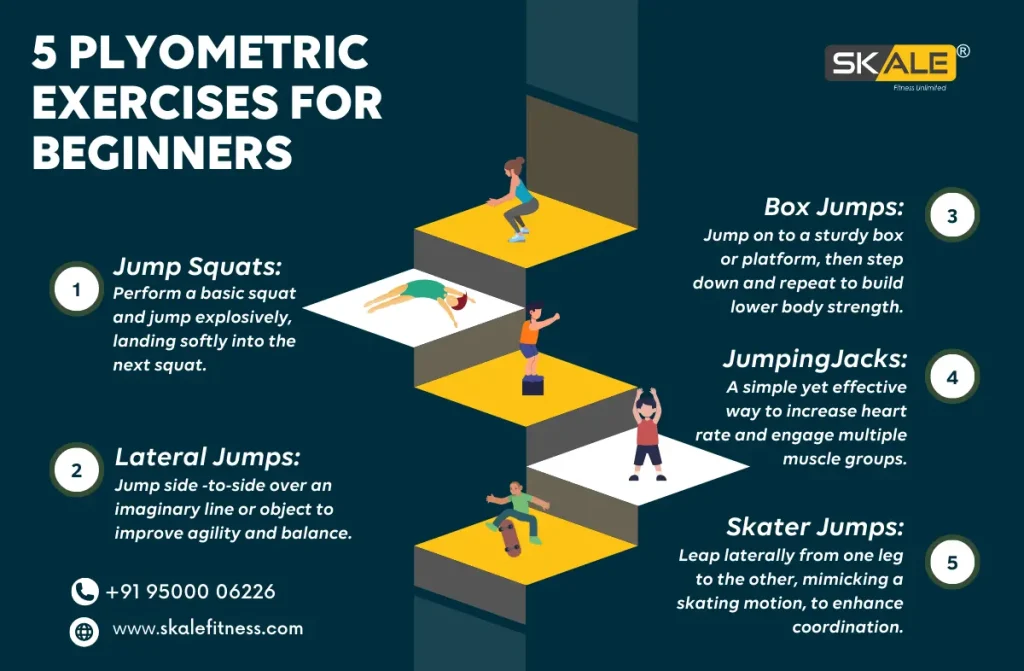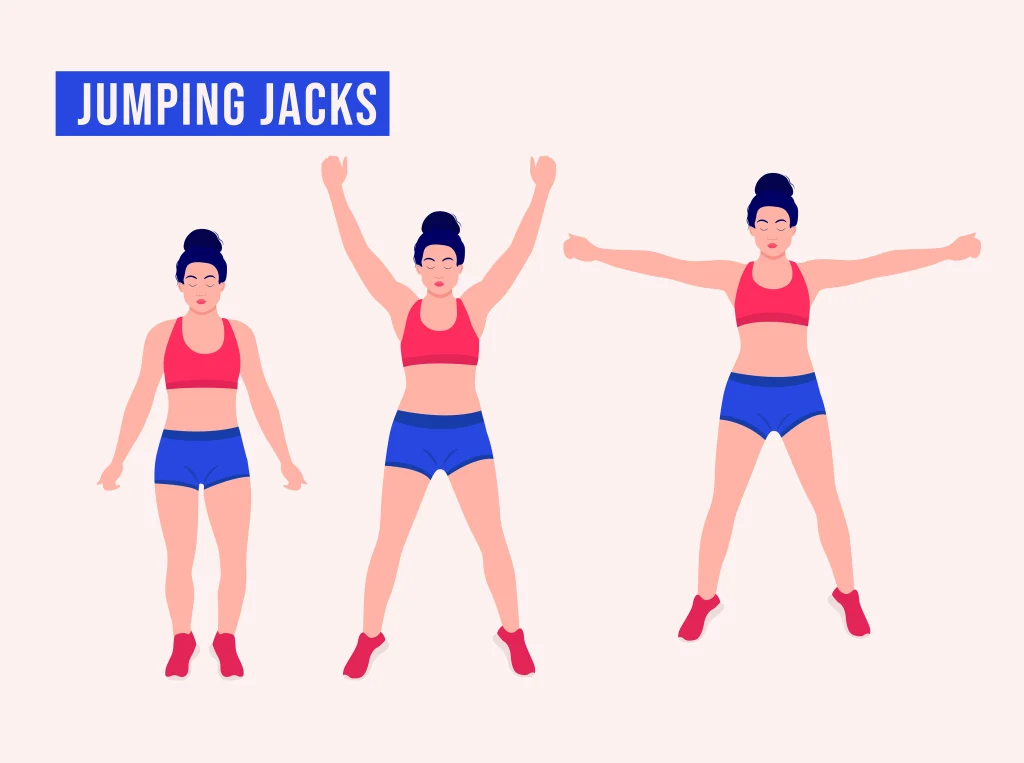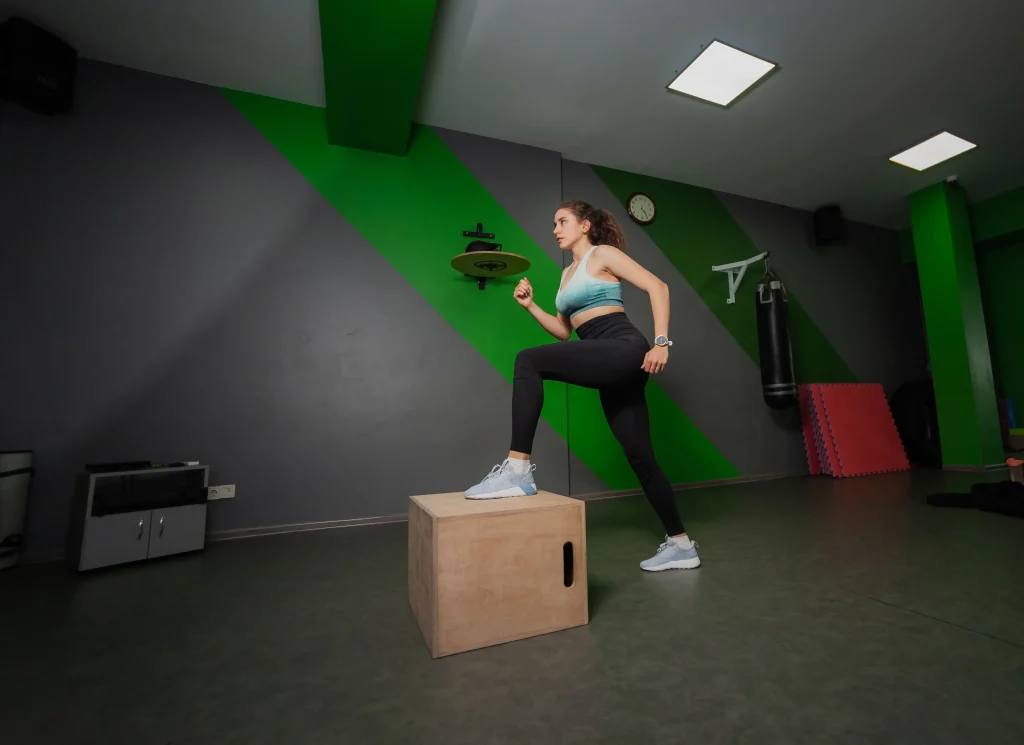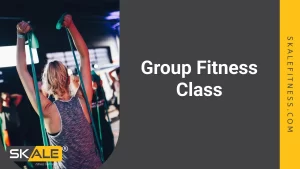Starting on a fitness adventure can be both thrilling and challenging, especially for beginners. To build explosive power, agility, and strength simultaneously, it’s crucial to start with the right workouts. Plyometric exercises for beginners provide an excellent option to achieve these goals.
These dynamic movements, such as box jumps and squat jumps, not only enhance overall fitness but also lay a solid foundation for more advanced training. Incorporating plyometric exercises ensures a well-rounded and effective start to the fitness journey.
What are Plyometric Exercises?
Plyometric exercises are dynamic movements that focus on rapid muscle contraction, aiming to enhance power and agility. These high-intensity exercises involve stretching a muscle (eccentric phase) then immediately contracting it (concentric phase) to generate explosive force. Common plyometric moves include box jumps, depth jumps, and bounding exercises like plyometric push-ups or jump squats. They target fast-twitch muscle fibers, improving muscle elasticity and nervous system coordination.
Plyometrics boost athletic performance in activities requiring speed and strength, like sprinting, basketball, or martial arts. However, they demand proper form and caution due to their high impact nature, making it crucial to start gradually and progress slowly to prevent injuries while reaping their benefits.

Benefits of Plyometric Exercises for Beginners
Before delving into particular exercises, let’s examine the multitude of advantages that come with integrating plyometrics into your workout regimen. Plyometric workouts are designed to enhance muscular power, speed, and agility. They engage multiple muscle groups, making them an efficient way to burn calories and improve cardiovascular health. Additionally, plyometric exercises can enhance bone density and boost overall athletic performance.
Jumping Jacks

Our first stop on the plyometric journey is the classic Jumping Jacks. Simple yet effective, Jumping Jacks are a fantastic way to introduce your body to the concept of explosive movements. Start with a moderate pace and gradually increase intensity as you become more comfortable. The rhythmic nature of Jumping Jacks not only improves cardiovascular fitness but also engages your leg muscles, enhancing strength and endurance.
Jump, spreading your feet wide while simultaneously raising your arms overhead. Return to the initial position and continue repeating the action. Aim for 3 sets of 15-20 repetitions to kickstart your plyometric journey.
Plyometric exercises for beginners like Jumping Jacks lay a solid foundation for more advanced movements, preparing your body for the challenges ahead.
Box Jumps

As you progress in your plyometric exercises for beginners, it’s time to elevate—literally. Box Jumps are an excellent way to enhance lower body strength, explosive power, and coordination. Find a sturdy box or platform, ensuring it’s at a height that challenges you but remains safe. Gradually increasing the height as your fitness improves ensures a progressive challenge in your plyometric training journey, promoting both safety and continued growth in strength and agility for beginners.
To perform Box Jumps, stand in front of the box with feet shoulder-width apart. Land softly with slightly bent knees, then step back down. Begin with a lower height and gradually increase as your confidence and strength grow.
Incorporating plyometric workouts for beginners like Box Jumps adds a dynamic element to your routine, promoting muscle growth and improved athletic performance.
Burpees

This plyometric exercise combines strength training with cardiovascular benefits, making it a must-have in any beginner’s routine. Burpees engage multiple muscle groups, including the chest, arms, legs, and core, providing an efficient way to torch calories and build endurance.
To perform Burpees, start in a standing position, then squat down and place your hands on the ground. Jump your feet back into a plank position, perform a push-up, then jump your feet back towards your hands. Finish by explosively jumping into the air, reaching your arms overhead. Land softly and repeat. Aim for 3 sets of 8-12 repetitions to challenge your body and elevate your fitness level.
Incorporating plyometric exercises for beginners like Burpees into your routine adds variety and intensity, ensuring a well-rounded fitness experience.
Medicine Ball Slams

As you advance in your plyometric journey, it’s time to introduce external resistance. Medicine Ball Slams are a powerful addition to plyometric exercises for beginners, targeting the entire body while incorporating an explosive element. This exercise not only builds strength but also enhances your ability to generate force quickly. Start with a manageable weight and gradually progress, ensuring a safe and effective introduction to the benefits of plyometrics for individuals at the beginner level.
To perform Medicine Ball Slams, stand with your feet shoulder-width apart, holding a medicine ball overhead. Engage your core and slam the ball onto the ground with force, then quickly catch it on the rebound. Aim for 3 sets of 10-15 repetitions, choosing a weight that challenges you but allows for proper form.
Plyometric workouts for beginners should progressively introduce more challenging exercises, and Medicine Ball Slams fit the bill by requiring coordination, power, and core stability.
Starting Plyometric Training
- Understanding Plyometrics:
- Plyometrics, or jump training, involves explosive movements that improve power, strength, and agility. Plyometric Exercises for Beginners focus on low-impact variations to help you build a solid foundation before progressing to more intense moves.
- It’s essential to start with a Beginner Plyometric Workout that prioritizes proper form and technique, reducing the risk of injury while maximizing benefits.
- Preparation and Warm-Up:
- Before diving into Plyometrics for Fitness Beginners, ensure your body is adequately warmed up. A 5-10 minute warm-up involving dynamic stretches and light cardio will prepare your muscles and joints for the explosive movements of plyometric training.
- Consistency is key. Start with 1-2 sessions per week, gradually increasing intensity and frequency as your body adapts to the demands of plyometric exercises.
Plyometrics: Three Explosive Exercises Even Beginners Can Try
- Jump Squats:
- How to Perform: Start in a squat position with your feet shoulder-width apart. Push through your heels to jump explosively into the air, then land softly back into the squat position.
- Benefits: Jump squats are a fundamental Plyometric Exercise for Beginners, helping to build lower body strength, power, and coordination. They are an essential component of any Beginner Plyometric Workout.
- Lateral Bounds:
- How to Perform: Stand on one leg and push off laterally to jump to the side, landing softly on the opposite leg. Alternate sides with each jump.
- Benefits: Lateral bounds are great for improving lateral movement, balance, and agility. They are perfect for beginners looking to incorporate more dynamic movements into their Plyometrics for Fitness Beginners routine.
- Box Step-Ups with Jump:
- How to Perform: Stand in front of a sturdy box or step. Step up with one foot, then push through that foot to jump off the box, landing on the same foot. Alternate legs with each repetition.
- Benefits: This exercise helps build explosive power in the legs while also improving balance and coordination. It’s a safe and effective introduction to plyometric training for beginners.
By incorporating these Plyometric Exercises for Beginners into your routine, you’ll start building the explosive power and strength that plyometrics are known for. Whether you’re new to fitness or just starting with plyometrics, these exercises will help you gradually increase your agility and endurance while minimizing the risk of injury.
Conclusion
Starting on a journey of plyometric exercises for beginners opens the door to improved strength, agility, and overall fitness. From the foundational Jumping Jacks to the dynamic Burpees and challenging Medicine Ball Slams, each exercise serves a specific purpose in enhancing your physical capabilities. Remember to start at your own pace, gradually increasing intensity as your strength and confidence grow.
Also, Read Personal Training Chennai.





